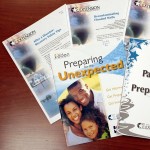AgriLife Extension supporting National Preparedness Month efforts in Texas
Writer: Paul Schattenberg, 210-859-5752, [email protected]
Contact: Dr. Joyce Cavanagh, 979-845-3859, [email protected]
Dr. Andy Vestal, 979-862-3013, [email protected]
COLLEGE STATION — The recent devastation of many parts of southeastern Texas by Hurricane Harvey has been a stark reminder of the need for Texans to be aware of and prepare for emergencies and disasters, said Dr. Andy Vestal, Texas A&M AgriLife Extension Service emergency management specialist, College Station.

“September has been designated National Preparedness Month by the Federal Emergency Management Agency, and AgriLife Extension Service is doing its part to support FEMA’s disaster and emergency preparedness efforts in Texas,” Vestal said. “We hope Texans will take this opportunity to make plans to protect themselves, their families, their homes and their businesses. We also hope they will seriously consider preparing a disaster plan that also accounts for any specific or special needs that may arise.”
Vestal said some of those specific or special needs might include making provisions for small children, disabled people, seniors or family pets.
He said the Texas Extension Disaster Education Network at http://texashelp.tamu.edu has materials on disaster preparation and recovery. Materials are also available at Texas A&M AgriLife Extension Bookstore, http://www.agrilifebookstore.org, with most available in English and Spanish.
Vestal also said FEMA and the Ready Campaign are using social media and other means to garner public attention and help people prepare for natural disasters and other emergency situations.
“Emergency coordinators, educators and community members can use the free resources offered and copy and paste social media campaigns to promote disaster preparedness to their audiences,” he said.
For more information, go to https://www.ready.gov/september
“They are encouraging families to talk about emergency preparedness and to develop a family emergency plan,” he said. “These efforts are to help everyone be aware of what to do, where to go and how to respond if there’s a disaster or emergency.”
Dr. Joyce Cavanagh, AgriLife Extension family development and resource management specialist, College Station, said one of the best things Texans can do is map out a family evacuation plan ahead of time and practice it. The plan should include establishing escape routes and making sure to include all members of the household in a practice session.
“Each room should have two exit points, and be sure to select a site outside the home for everyone to meet after they’ve left the house,” she said. “Prepare a contact card with the name, address, phone and email for each family member, and have everyone keep a copy of it in a wallet, purse or backpack for easy reference.”
She said special assistance may be available in some areas by calling 2-1-1 and registering for such assistance.
“If 2-1-1 is not available in your area, call the local emergency management office or fire department to ask about any special assistance programs that may be offered,” she said.
A disaster plan should also include how to care for pets, Cavanagh said.
“This might include identifying hotels or motels that accept pets or would waive a no-pets policy in an emergency and listing phone numbers and addresses of veterinarians’ offices,” she said. “You may also want to identify possible pet-boarding facilities or coordinate with friends outside the area to care for the pets. Be sure to include pet food and pet comfort items as well as pet vaccination records in your emergency supply kit.”
More information on preparedness can be found on Facebook, https://www.facebook.com/agrilifeextension, Twitter at https://twitter.com/txextension, and Pinterest at https://www.pinterest.com/txextension/disaster-education.


